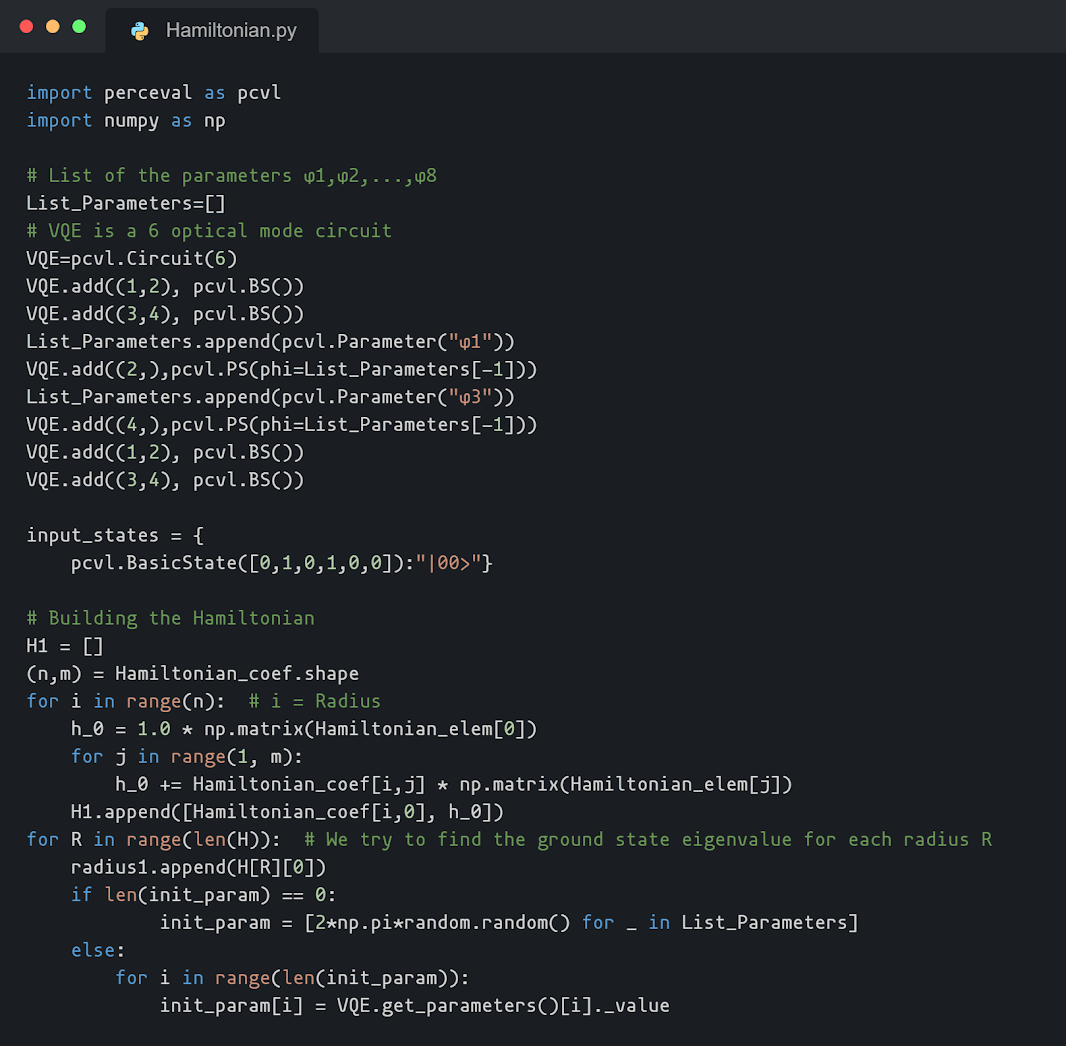OUR APPROACH
There are hard computational problems all around in any industry – Quandela leverages the power of single photons to solve complex problems. Let us show you how with an example.
QUANTUM ALGORITHM DESIGN
Crafting Algorithms to Decode Molecular Mysteries
Our team develops quantum algorithms tailored to unravel complex molecular structures. We specialize in techniques like the Variational Quantum Eigensolver (VQE), which can efficiently compute the ground-state energy, potential energy surface of molecules, and other properties that can be formulated as an energy minimization problem, a task that becomes exponentially challenging for classical computers as molecular complexity increases.
These problems can be modelled mathematically
through a so-called fermionic Hamiltonian formulation:
which can be mapped to a linear sum of Pauli strings (Qubit Hamiltonian), the evaluation of which is suited to quantum computers
And represented with a quantum algorithm
With our algorithm designed, we leverage the power of our cloud platform to bring molecular simulations to life.
QUANDELA CLOUD
This is where the power of our cloud infrastructure comes into play
The quantum algorithm is deployed to our advanced quantum processors through Quandela Cloud. This cloud-based approach ensures that our cutting-edge quantum solutions are accessible and scalable, allowing researchers and businesses to harness the full potential of photonic quantum computing from anywhere in the world.
Those algorithms are run through Quandela Cloud
While the cloud provides the interface, the true quantum magic happens in our proprietary hardware.
QUANTUM COMPUTERS
Photonic Quantum Computer : Where Quantum Meets Reality
Our cutting-edge photonic Quantum Processing Units (QPUs) are the culmination of years of research and engineering. These processors, designed and manufactured by Quandela, leverage the power of light to perform quantum computations.

The qubit generator
At the hearth of the Quantum Computer, our quantum dots are emitting single-photons that are “flying qubits” that will go through configurable interference to perform quantum computations
Precision Photon Routing
Active demultiplexer followed by fibered delays converts the train of single photons into parallel photons arriving at the same time in the photonic chip
Photonic Chip
In the chip, the single photon state go through a configurable unitary transformation, actually realizing the user circuit.
Single Photon Detection
Photons are detected at the chip output by superconducting nanowire single-photon detectors and detection times are processed by a correlator
While our quantum hardware orchestrates the computations, the molecular structures materialize in the interpretation of results
INTERPRETING QUANTUM RESULTS
From raw Data to Molecular Insights
Our cutting-edge photonic Quantum Processing Units (QPUs) are the culmination of years of research and engineering. These processors, designed and manufactured by Quandela, leverage the power of light to perform quantum computations.
Resulting in Sample Distribution
Our photonic quantum computer produces a distribution of samples representing possible molecular states. Visualized as a histogram, each bar represents a specific quantum state, with its value indicating probability. This distribution encapsulates the quantum nature of the molecule, showing all possible configurations simultaneously.


INTERPRETED THROUGH USER ALGORITHM
The sample distribution is processed using a user-defined algorithm, typically in Python. This algorithm translates quantum states into energy levels, identifies the ground state(lowest energy configuration) which can be used to construct a potential energy surface for the molecule and its possible configurations. It bridges the quantum world and our classical understanding of molecular geometry.
PROVIDING DIRECT SOLUTION
The final output is a detailed 3D model of the molecule in its most stable configuration. This visualization brings quantum results into a tangible form, showing the spatial arrangement of atoms, bond lengths, and angles. It provides crucial insights for applications in drug design, materials engineering, and fundamental chemistry research.

FIND OUT MORE
Understand more about VQE algorithms
and see more application examples on
our Quantum Processor Units
Learn more about developing quantum algorithms (develop page from Quandela Hub).

